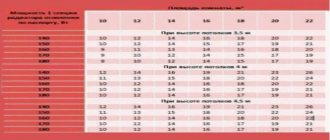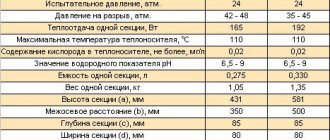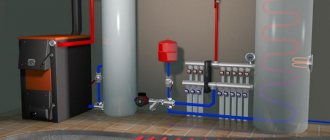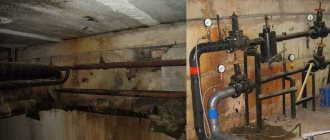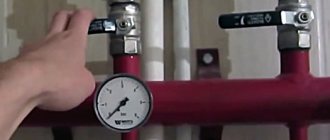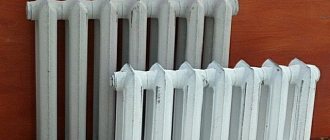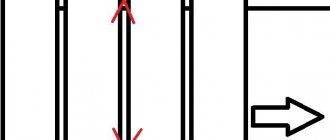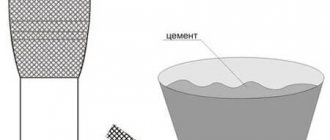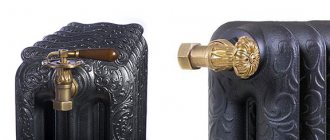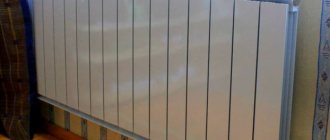In what cases is the coolant volume calculated?
The liquid in the water circuit of the heating system performs the most important function - it is a heat carrier. Many elements of the heating system are selected relative to the volume of coolant being distilled. Therefore, preliminary calculations will allow you to complete the heat supply most efficiently. It is easy to calculate the total volume of coolant, given that the amount of liquid in radiators is 10-12 percent of the total amount of liquid being distilled.
Calculation of water in the heating system must be done in the following cases:
- before installing heating, determine the amount of coolant that will be distilled by a boiler of a certain power;
- when non-freezing liquid is poured into the system, it is necessary to maintain a certain proportion in relation to the entire distilled liquid;
- the size of the expansion tank depends on the amount of coolant;
- you need to know the required volume of water in the heating system of country or private houses where the water supply is not centralized.
In addition, in order to properly mount the batteries on the wall, you need to know their weight. For example, just one section of a cast iron radiator, already heavy, holds 1.5 liters of liquid. That is, the seven-section cast-iron battery becomes more than ten kilograms heavier when the system starts.
Why do you need to know the amount of water in the battery?
In most cases, attention is paid to radiators at the beginning or end of the heating season or during the main cleaning. At the same time, extremely important processes for humans take place, for which the coolant is responsible - much more often water. Is there any value in information about how much of this liquid fits into one battery or section?
It turns out that there are more than one reasons for this:
- do not “weight” the heating device , due to the fact that the amount of water in a cast iron heating radiator increases its already heavy weight,
- installation of a heating system with a certain boiler power requires calculation of the total amount of coolant , including in radiators,
- knowing that the amount of coolant in the battery forms 10–12% of the heating system - all batteries, pipes and boiler, it is possible to drain the water “dry”,
- when choosing an expansion tank,
- so as not to overdo it with concentrated antifreeze , which is poured in a certain proportion with water,
- for the natural/forced type of circulation, the optimal size of the battery is selected - huge in the first case and no difference in the second.
What situations can be avoided if you correctly calculate the volume of coolant
Many people install a heating system, relying on the advice of experts, friends or their own intuition. Choose a more powerful boiler and increase the number of radiator sections “just in case.” But the result is the opposite picture: instead of the expected heat, the batteries do not warm up evenly, the boiler “winds” fuel idle.
You can avoid the following unpleasant situations if you know how to calculate the amount of water in the heating system:
- uneven heating of the water circuit in the rooms;
- increased fuel consumption;
- emergency situations (broken connections, leaks in radiators).
All these “surprises” are quite predictable if the volume of coolant is incorrectly calculated.
Attention! Antifreeze should not be used in a heating system that uses galvanized pipes or other elements.
Summarizing
The principle is better to underfill than the opposite; it is not applicable in heating systems, since airing the system will mean cold radiators. By calculating the volume of each structural element of the heating system using tables or empirically, heat consumption will become more meaningful and enjoyable. And repairing or replacing a separate fragment will no longer be a sealed secret.
The video in this article shows the process of pouring coolant into the heating system.
The coolant in the heating system is not only tap water, which is pumped inside due to its pressure. For example, in country villages, water is often poured into the heating system in buckets, taken from a well or a nearby reservoir. Or even use non-freezing liquids. The second option is used infrequently only because of the high cost of the material, but those who plan to live in a dacha or country cottage only on weekends and holidays use antifreeze liquids so as not to drain the coolant from the heating system each time. Therefore, calculating the volume of coolant is an important indicator, which includes the volume of the heating radiator, the volume of pipes and the heating boiler.
The boiler capacity is indicated in the product passport. This indicator will mainly depend on the power of the unit and its size. The volume of pipes can be determined from special tables, of which there are a large number on the Internet. We also offer the following table:
| Diameter (mm) | Volume of one linear meter (l) |
| 15 | 0,177 |
| 20 | 0,31 |
| 25 | 0,49 |
| 32 | 0,8 |
| 40 | 1,25 |
| 50 | 1,96 |
To determine the total volume of the required coolant, which will fit only in the pipes, it is necessary to measure their total length and multiply by the indicator from the table. If you are using a project to build a heating system, then all the necessary calculations and measurements can be carried out using it.
What can you take from the documentation?
Technical data sheets for devices, if available, will help you find out how much water will circulate in the heating radiator and boiler during operation of the heating system.
If you need to choose a radiator based on coolant volume, you can compare different options:
- aluminum and bimetallic with a height of 300 and 500 mm hold 0.3 and 0.39 l/m, respectively;
- cast iron MS-140 with a height of 300 and 500 mm. holds 3 and 4 l/m respectively;
- an imported cast iron radiator with a height of 300 and 500 mm will include 0.5 and 0.6 l/m.
Thus, the volume of a bimetallic radiator is the same as that of an aluminum radiator.
Another “cheat sheet” will help when selecting cast iron radiators of different models (the amount of coolant per section is indicated):
- MS 140 – 1.11–1.45 l
- World Cup 1 – 0.66–0.9 l s;
- World Cup 2 – 0.7–0.95 l;
- World Cup 3 – 0.155–0.246 l;
As for pipes, the calculations are as follows.
Based on the internal diameter of the pipes, in the documentation you can find out the amount of liquid they contain per linear meter:
- 13.2 mm - 0.137 l;
- 16.4 mm - 0.216 l;
- 21.2 mm - 0.353 l;
- 26.6 mm - 0.556 l;
- 42 mm - 0.139 l;
- 50 mm - 0.876 l.
The calculations are simple. So, for example, a 5-meter pipe with an internal diameter of 50 mm will hold 4.4 liters of water: 5x0.876 = 4.4
Attention! If you compare how many liters of water are in heating radiators of different models, you can choose the appropriate option that matches the power of the boiler.
The volume of water in the heating system: how to calculate and what does it affect?
Volume of water in the heating system
Many of us, faced with the installation or reconstruction of a heating system, wonder how to calculate how much water is in the heating system?
The answer is simple - take a sheet of paper, a pen and a calculator. First of all, you need to understand that the total volume will be equal to the sum of the volumes of each element of the system. Below we provide the values for the most common elements.
Calculation of coolant in radiators:
- Type 11 – 0.25 l for every 10 cm of radiator length (for radiator models with a height of 500 mm)
- Type 22 – 0.5 l for every 10 cm of radiator length (for radiator models with a height of 500 mm)
If you need to calculate the volume for radiators of non-standard height (for example, 300, 400, 600 mm), use the interpolation method. For example, the volume of a heating radiator of type 22 with a height of 300 = 0.5 l / 500 * 300 = 0.3 l. Depending on the manufacturer, the data may fluctuate, but not significantly.
For sectional radiators:
Amount of coolant in pipes:
- dia. 20 mm – 0.17 l/meter running pipe
- dia. 25 mm – 0.3 l/m
- dia. 32 mm –
- dia. 40 mm –
- dia. 50 mm –
- dia. 1/2 inch (15 mm) – l/meter running pipe
- dia. 3/4 inch (20 mm) –
- dia. 1 inch (25 mm) –
- dia. 1.5 inches (40 mm) –
- dia. 2 inches (50 mm) –
Volume of water in the boiler
For floor and parapet, depending on the power and, accordingly, the size of the boiler, the value ranges from 10-30 liters. You can be more precise by looking at the characteristics of the device itself.
In this simple way, adding up all the values. we can determine the volume of the system.
Note:
It would be advisable to calculate the amount of coolant in the system if:
- we determine what volume we need an expansion tank
- how much coolant do we need (if we fill in antifreeze)
- we choose a circulation pump
- theoretically I admit that I missed something. If you find this, write me an email and I will definitely take it into account!
There is absolutely no point in calculating the volume in order to:
- calculate how much less gas consumption will be if pipes are replaced with radiators (there is a relationship, but it is not directly proportional, the calculation will not be correct).
- select boiler power. Choosing a boiler based on the amount of water in the system is not logical. After all, our ultimate goal is not to provide heating of water, but to compensate for the heat losses incurred by our building.
This is a simple way to calculate the volume of coolant in the heating system. I hope the article was useful. Warmth and comfort to you!
The amount of coolant in the depths of radiators is an abstract quantity for many. The volume of this liquid affects the inertia of the heating system, warm-up time and boiler operating mode. The ability to calculate the volume of water in any part of the heating system will allow you to more accurately select the remaining equipment for it (boiler, circulation pump, etc.).
How to calculate the amount of coolant in radiators yourself
Sometimes you have to face a situation where it is impossible to determine whether radiators belong to a certain model. Documents for radiators may be lost, the model name is not visible. There is an easy way to find out how many liters are in a heating radiator without resorting to documentation or tables from the Internet.
Proceed as follows:
- close one side of the radiator with a plug;
- pour liquid to the top;
- pour the liquid into a measuring container.
Attention! There are two options for calculating the volume of water in a heating radiator: immediately note the amount of liquid poured in, or after draining it.
In this simple way you can calculate the amount of liquid that enters a radiator of any complexity or model.
Calculation of volume in sections of popular heating radiators
When building any heating system, different types of radiators are used. Any heating system must be designed taking into account the number of radiators and their internal volume. Each radiator section has a certain volume, and when installing a heating system, you need to know for sure the number of sections in the battery. The efficiency and proper operation of the heating system depends on the correct calculation of the number of sections.
What types of heating radiators are there?
Today the following types of radiators are most often used:
- cast iron radiators;
- aluminum alloy radiators;
- bimetallic radiators.
Standard
These units are available in a range of heights, typically from 300mm to 750mm, with the largest range of lengths and height configurations ranging from 450mm to 600mm high. Lengths vary from 200mm to 3m or more, with the largest range being 450mm to 2m in length.
Panels and convectors
Such radiators usually consist of one or two panels, but sometimes 3-panel ones are found. Modern single panel radiators have a corrugated panel forming a series of fins (called "convectors") attached to the rear (wall-facing) side of the panel, which increases the convection power of the battery.
They are commonly known as "single convector" (SC). Radiators consisting of two panels with fins stacked on top of each other (with fins in the middle) are known as "dual convector" (DC). There are also double radiators, consisting of one finned panel and one without fins.
Older design radiators consisted of one or two panels without any convection fins.
A traditional standard radiator has seams on the top, sides and bottom of each panel (where the pressed sheets of steel are joined together). Nowadays, most seamed batteries are sold with decorative panels installed on the top and sides (the top ones have vents for air circulation) and are known as "compact" batteries. An alternative to the top seam radiator design uses a single sheet of pressed steel and this sheet is joined in a "roll" fashion at the top of the radiator.
Low surface temperature batteries
Most of these radiators are designed so that their radiating surfaces have relatively low temperatures at normal heating system temperatures. They are used where there may be a risk of burns - most often in children's institutions, nursing homes, hospitals and hospitals.
Designer batteries
There is a huge selection of radiator designs available that can be more pleasing to the eye than their conventional counterparts. Some designer radiators are available in tall, narrow configurations which may be suitable for rooms with, for example, narrow walls near doors where conventional radiators cannot provide sufficient power with limited wall space available.
Skirting radiators
These devices are usually disguised as baseboards. The operation of these radiators is similar to the effect of a “warm floor”, since the user’s eye does not notice any radiator sections on the walls. Installing skirting boards allows you to save interior space.
Heated towel rails
Such radiators are specially designed for drying towels, as well as for drying bathtubs and showers.
However, the thermal output of heated towel rails is significantly reduced when covered with towels, and even if they are not covered with towels, heated towel rails are able to dissipate much less heat than conventional radiators of similar size. Heated towel rails are usually not enough to heat rooms.
They are used only in relatively small and well-insulated bathrooms. Some heated towel rail designs contain a regular radiator with towel racks above and sometimes on the sides of the radiator. Such devices have better thermal power.
The amount of coolant in the heating battery
The correctly selected volume of coolant in the section allows the heating radiator to operate most optimally. The amount of water in the radiator affects not only the operation of the boiler, but also the efficiency of all elements of the heating system. The most rational selection of other equipment included in the heating system also depends on the correct calculation of the volume of water or antifreeze.
The volume of coolant in the system also needs to be known in order to select the correct expansion tank. For houses with a central heating system, the volume of radiators is not so important, but for autonomous heating systems, the volume of water in the radiator sections needs to be known for certain. You also need to take into account the volume of the heating system pipelines so that the heating boiler operates in the correct mode. There are special tables for calculating the internal volume of heating system pipelines. You just need to correctly measure the length of the heating circuit pipes.
Critical stage: calculating the capacity of the expansion tank
In order to have a clear idea of the displacement of the entire heating system, you need to know how much water is placed in the boiler heat exchanger.
You can take averages. So, on average, a wall-mounted heating boiler contains 3-6 liters of water, while a floor or parapet boiler contains 10-30 liters.
Now you can calculate the capacity of the expansion tank, which performs an important function. It compensates for the excess pressure that occurs when the coolant expands when heated.
Depending on the type of heating system, tanks are:
- closed;
- open.
For small rooms, the open type is suitable, but in large two-story cottages, closed expansion joints (membrane) are increasingly being installed.
If the tank capacity is smaller than required, the valve will release pressure too often. In this case, you have to change it, or install an additional tank in parallel.
For the formula for calculating the capacity of the expansion tank, the following indicators are needed:
- V(c) is the volume of coolant in the system;
- K is the coefficient of water expansion (the value is taken as 1.04, based on the water expansion rate of 4%);
- D is the expansion efficiency of the tank, which is calculated by the formula: (Pmax – Pb)/(Pmax+1)=D, where Pmax is the maximum permissible pressure in the system, and Pb is the pre-pumping pressure of the compensator air chamber (parameters are indicated in the documentation for the tank );
- V(b) - expansion tank capacity.
So, (V(c) x K)/D = V(b)
Weight of one radiator section. How much does one section of an old-style cast iron battery weigh?
You need to have information about how much a cast iron heating radiator weighs for a number of reasons. For example, if batteries are purchased for installation throughout a private household, you need to calculate the carrying capacity of the vehicle transporting the heating devices, and you must also decide on the number of loaders who will carry them into the house.
For clarity, you can compare the weight of cast iron radiators of outdated models and modern analogues made of other materials:
- one section of standard cast iron batteries with a center distance of 500 mm weighs 5.5 - 7.2 kilograms, and with a center distance of 300 millimeters - from 4.0 to 5.4 kilograms;
- the weight of the fins of non-standard cast iron heating appliances ranges from 3.7 to 14.5 kilograms;
- the aluminum battery section weighs 1.45 kilograms with an interaxle spacing of 500 millimeters, and 1.2 kilograms with 350 millimeters;
- bimetallic devices with an interaxial distance of 500 millimeters weigh 1.92 kg/section, and with 350 millimeters - 1.36 kg/section.
When carrying out repairs and replacing heating equipment in a house, it is important for its owners to know how much an old cast-iron radiator weighs in order to decide whether it will be possible to take the old multi-section radiator outside on their own, since it is necessary to calculate their own strength. But there is no such data.
The reason is that there are different models in use. Moreover, they have the same purpose, but different weights. In addition, devices that differ in size and variety of shapes are sold on the domestic market.
Today, for example, there are more than several dozen names of traditional cast iron batteries, and it is difficult to count models made in a designer style. At the same time, such a parameter as the weight of one section of a cast iron radiator is very different.
Aluminum or cast iron?
The long-lived cast iron radiator has both its pros and cons compared to modern competitors.
- Cast iron has high corrosion resistance. The basic coolant in a water heating system is water, which comes from the thermal power plant through many kilometers of pipes to the elevator units of houses and industrial buildings. Many heating mains have been laid for a long time and debris and rust accumulate in them. Cast iron parts of the heating main “steadfastly” withstand these negative factors and last for many years, unlike many modern materials. Plumbing fixtures made of cast iron are resistant to water hammer.
- Long service life. Cast iron radiators are designed for a service life of 50 years, subject to periodic flushing and cleaning.
- A real find for stylists and interior designers. Fits perfectly into retro-style rooms.
- High energy consumption is rather a disadvantage of batteries than their advantage. Cast iron batteries have a long period of both heating and cooling of the surface. When calculating overall energy efficiency, cast iron appliances are inferior to modern-generation heating appliances. And yet, their use when connected to central heating networks is considered appropriate.
- Considerable weight. When calculating the number of sections, it is necessary to take into account the total weight of the heat source. If a cast iron radiator weighing more than 50 kg is mounted into a solid concrete or brick wall, then fasteners with a large cross-section are sufficient. When fastening in other types of structures, additional fasteners are required. If installation rules are violated, the integrity of the wall and its load-bearing elements may be compromised.
Now you not only know how much a cast iron battery weighs, but also all its advantages and disadvantages.
Weight of standard heating devices
Both traditional and designer pieces are united by the material of manufacture, which is cast iron.
And now, well-functioning classic accordion-shaped radiators are found everywhere, installed:
- in schools and preschool educational institutions;
- in outpatient departments and hospitals;
- in housing stock premises - apartments, private households, dormitories;
- in public and government institutions.
